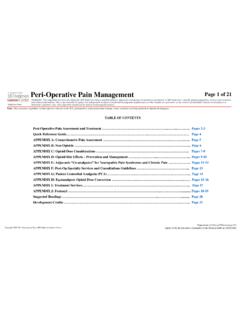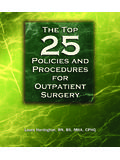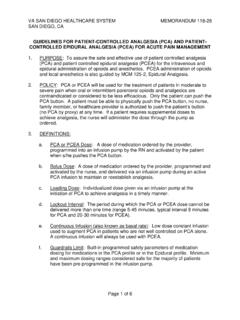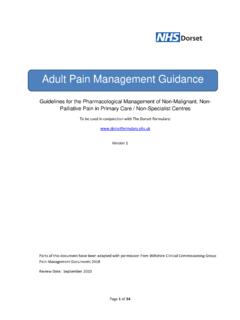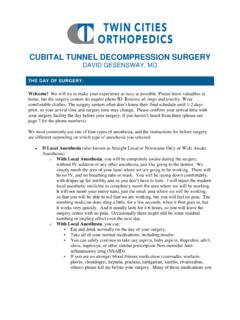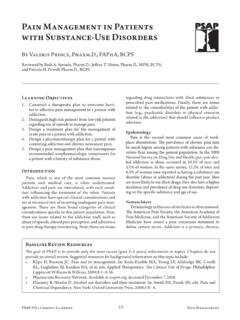Transcription of Symptom Management Guidelines: Nausea and Vomiting
1 Symptom Management Guidelines: CANCER RELATED Nausea AND Vomiting . Definition Nausea : A subjective phenomenon of an unpleasant, wavelike sensation experienced in the back of the throat and/or the epigastrium. Nausea may or may not result in Vomiting - it is the patient's perception that Vomiting may occur. Vomiting : The forceful expulsion of the contents of the stomach, duodenum, or jejunum through the oral cavity. Contributing Factors Cancer Treatments Chemotherapy: For emetogenicity of chemotherapeutic agent, See Appendix A and Cancer Drug Manual in Resources Section NOTE: Protocols with highly emetogenic chemotherapy (HEC) and Moderately Emetogenic Chemotherapy with cyclophosphamide and an anthracycline combined (MEC-A) increase risk for Nausea and Vomiting Immunotherapy Checkpoint inhibitors Biotherapy : High dose Interferon or Interleukin-2.
2 Radiation Therapy: GI tract, liver, brain NOTE: The greater the amount of daily fractional doses, the increased likelihood of radiation induced Nausea and Vomiting Surgery Medication Antibiotics Opioids &/or Opioid withdrawal NSAIDs SSRI antidepressants Iron supplements Anticonvulsants Antiarrhymics Cancer Related Gastric cancer Tumour growth in the GI tract or CNS. Brain metastases Reduced GI motility or Bowel Obstruction Gastroparesis, tumour or chemotherapy induced ( vincristine). Other Constipation Vestibular dysfunction Anxiety, anticipatory Nausea Hypercalcemia, hyperglycemia, hyponatremia Peptic ulcer disease Infections of the mouth, pharynx or esophagus Uremia More common in women than men More common in younger patients (less than 50).
3 Decreased risk for patients with a high chronic alcohol intake Motion sickness Conditions that may require the use of warfarin ( venous thrombosis, cardiac surgeries). The information contained in these documents is a statement of consensus of BC Cancer Agency professionals regarding their views of currently accepted approaches to treatment. Any clinician seeking to apply or consult these documents is expected to use independent medical judgement in the context of individual clinical circumstances to determine any patient's care or treatment.
4 Use of these documents is at your own risk and is subject to BC Cancer Agency's terms of use, available at Page 1 of 8. Consequences Dehydration Aspiration pneumonia Malnutrition Anorexia Wound dehiscence Esophageal tears Chemotherapy dose delays, reductions, discontinuations of treatment Quality of life distress, compromised role function, decreased functional status, exacerbation of other symptoms ( pain , fatigue, sleep-wake disturbance). Decreased nutritional intake from Nausea and Vomiting may lead to increased INR or increased risk of bleeding for patients on warfarin Focused Health Assessment GENERAL ASSESSMENT Symptom ASSESSMENT PHYSICAL ASSESSMENT.
5 Contact and General Normal Vital Signs Information Did you have Nausea / Vomiting prior to your treatment Frequency as clinically Physician name - starting? indicated oncologist, family Are you aware of any medications that you are taking physician that could cause Nausea and Vomiting ( warfarin, Weight Pharmacy antibiotics) Take current weight and Home health care compare to pre . Onset treatment or last recorded Other healthcare providers When did the Nausea and/or Vomiting begin? weight Allergies How many episodes of Vomiting in the last 24 hours?
6 Hydration Status Provoking / Palliating Assess skin turgor, Consider Contributing What brings on the Nausea and/or Vomiting ? Factors capillary refill, mucous Is there anything that makes the Nausea / Vomiting membranes Cancer diagnosis and better? Worse? treatment(s) note type Amount and character of and date of last treatment Quality urine Medical history Describe the emesis? Colour (visible blood, coffee Medication profile ( ground emesis, bile)? Volume (large or small Abdominal Assessment warfarin, antibiotics) amounts)? Odour?
7 Auscultate abdomen - Recent lab or diagnostic Can you estimate the amount, large or small volume? assess presence and reports (if patient is on quality of bowel sounds warfarin consider Region / Radiation - NA Assess for abdominal increasing frequency of pain , tenderness, INR monitoring) Severity / other Symptoms distention How bothered are you by this Symptom ? (On a scale of 0 10, with 0 being not at all and 10 being the Emesis Examination worse imaginable) Inspect emesis for colour, What is the daily intake and output? consistency, quantity, Do you have Nausea with or without Vomiting ?
8 Odour and blood Have you had any other symptoms such as: - Abdominal cramping? Stomach pain ? Gas pain ? - Constipation? - When was your last bowel movement? - Fever? - possible infection - Dry mouth, thirst, dizziness, weakness, dark urine? possible dehydration - Blood, mucous in stool The information contained in these documents is a statement of consensus of BC Cancer Agency professionals regarding their views of currently accepted approaches to treatment. Any clinician seeking to apply or consult these documents is expected to use independent medical judgement in the context of individual clinical circumstances to determine any patient's care or treatment.
9 Use of these documents is at your own risk and is subject to BC Cancer Agency's terms of use, available at Page 2 of 8. Treatment What medications or treatments have you tried? Has this been effective? Understanding / Impact on You Are you able to keep fluids down? What are you drinking? How much? What do you believe is causing your Nausea ? Nausea AND Vomiting GRADING SCALES*. NCI Common Terminology Criteria for Adverse Events (Version ). GRADE 1 GRADE 2 GRADE 3 GRADE 4 GRADE 5. (Mild) (Moderate) (Severe) (Life Threatening).
10 Nausea Loss of appetite Oral intake Inadequate oral without alteration decreased without caloric or fluid in eating habits significant weight intake; tube __ __. loss, dehydration feedings, TPN or or malnutrition hospitalization indicated Vomiting 1-2 episodes 3-5 episodes >= 6 episodes Life-threatening Death (separated by 5 (separated by 5 (separated by 5 consequences;. minutes) in 24 minutes) in 24 hrs minutes) in 24 hrs; urgent intervention hours tube feeding, TPN indicated or hospitalization indicated * A semi-colon indicates or' within the description of the grade and a single dash (-) indicates a grade is not available *Step-Up Approach to Symptom Management : Interventions Should Be Based On Current Grade Level and Include Lower Level Grade Interventions As Appropriate GRADE 1 GRADE 2 OR.










